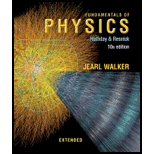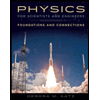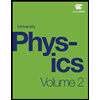
Fundamentals of Physics Extended
10th Edition
ISBN: 9781118230725
Author: David Halliday, Robert Resnick, Jearl Walker
Publisher: Wiley, John & Sons, Incorporated
expand_more
expand_more
format_list_bulleted
Concept explainers
Textbook Question
Chapter 22, Problem 35P
SSM WWW At what distance along the central perpendicular axis of a uniformly charged plastic disk of radius 0.600 m is the magnitude of the electric field equal to one-half the magnitude of the field at the center of the surface of the disk?
Expert Solution & Answer
Want to see the full answer?
Check out a sample textbook solution
Students have asked these similar questions
At what distance along the central axis of a uniformly charged plastic disk of radius R = 1.31 m is the magnitude of the electric field equal to 1/3 times the magnitude of the field at the center of the surface of the disk?
Charge is uniformly distributed around a ring of radius R = 2.40 cm, and the resulting electric field magnitude E is measured along the ring’s central axis (perpendicular to the plane of the ring). At what distance from the ring’s center is E maximum?
At what distance along the central perpendicular axis of a uniformly charged plastic disk of radius 0.600 m is the magnitude of the electric field equal to one-half the magnitude of the field at the center of the surface of the disk?
Chapter 22 Solutions
Fundamentals of Physics Extended
Ch. 22 - Figure 22-22 shows three arrangements of electric...Ch. 22 - Figure 22-23 shows two square arrays of charged...Ch. 22 - In Fig. 22-24, two particles of charge q are...Ch. 22 - Figure 22-25 shows four situations in which four...Ch. 22 - Figure 22-26 shows two charged particles fixed in...Ch. 22 - In Fig. 22-27, two identical circular...Ch. 22 - The potential energies associated with four...Ch. 22 - a In Checkpoint 4, if the dipole rotates from...Ch. 22 - Figure 22-28 shows two disks and a flat ring, each...Ch. 22 - In Fig. 22-29, an electron e travels through a...
Ch. 22 - In Fig. 22-30a, a circular plastic rod with...Ch. 22 - When three electric dipoles ire near each other,...Ch. 22 - Figure 22-32 shows three rods, each with the same...Ch. 22 - Figure 22-33 shows five protons that are launched...Ch. 22 - Sketch qualitatively the electric field lines both...Ch. 22 - In Fig. 22-34 the electric field lines on the left...Ch. 22 - SSM The nucleus of a plutonium-239 atom contains...Ch. 22 - Two charged particles are attached to an x axis:...Ch. 22 - SSM A charged particle produces an electric Held...Ch. 22 - What is the magnitude of a point charge that would...Ch. 22 - SSM ILW WWW In Fig. 22-35, the four particles form...Ch. 22 - GO In Fig. 22-36, the four particles are fixed in...Ch. 22 - GO Figure 22-37 shows two charged particles on an...Ch. 22 - GO Figure 22-38a shows two charged particles fixed...Ch. 22 - SSM Two charged particles are fixed to x axis:...Ch. 22 - GO Figure 22-39 shows an uneven arrangement of...Ch. 22 - GO Figure 22-40 shows a proton on the central...Ch. 22 - In Fig. 22-41, particle 1 of charge q1 = 5.00q and...Ch. 22 - In Fig. 22-42, the three particles are fixed in...Ch. 22 - Figure 22-43 shows a plastic ring of radius R =...Ch. 22 - Two charged beads are on the plastic ring in Fig....Ch. 22 - The electric field of an electric dipole along the...Ch. 22 - Figure 22-45 shows an electric dipole. What are...Ch. 22 - Equations 22-8 and 22-9 are approximations of the...Ch. 22 - SSM Electric quadrupole. Figure 22-46 shows a...Ch. 22 - Density, density, density. a A charge 300e is...Ch. 22 - Figure 22-47 shows two parallel nonconducting...Ch. 22 - A thin nonconducting rod with a uniform...Ch. 22 - Figure 22-49 shows three circular arcs centered on...Ch. 22 - GO ILW In Fig. 22-50, a thin glass rod forms a...Ch. 22 - GO In Fig, 22-51, two curved plastic rods, one of...Ch. 22 - Charge is uniformly distributed around a ring of...Ch. 22 - GO Figure 22-52a shows a nonconducting rod with a...Ch. 22 - GO Figure 22-53 shows two concentric rings, of...Ch. 22 - SSM ILW WWW In Fig. 22-54, a nonconducting rod of...Ch. 22 - GO In Fig. 22-55, positive charge q = 7.81 pC is...Ch. 22 - GO In Fig. 22-56, a semi-infinite nonconducting...Ch. 22 - A disk of radius 2.5 cm has a surface charge...Ch. 22 - SSM WWW At what distance along the central...Ch. 22 - A circular plastic disk with radius R = 2.00 cm...Ch. 22 - Suppose you design an apparatus in which a...Ch. 22 - Figure 22-58a shows a circular disk that is...Ch. 22 - In Millikans experiment, an oil drop of radius...Ch. 22 - GO An electron with a speed of 5.00 108 cm/s...Ch. 22 - SSM A charged cloud system produces an electric...Ch. 22 - Humid air breaks down its molecules become ionized...Ch. 22 - SSM An electron is released from rest in a uniform...Ch. 22 - An alpha particle the nucleus of a helium atom has...Ch. 22 - ILW An electron on the axis of an electric dipole...Ch. 22 - An electron is accelerated eastward at 1.80 ...Ch. 22 - SSM Beams of high-speed protons can be produced in...Ch. 22 - In Fig. 22-59, an electron e is to be released...Ch. 22 - A 10.0 g block with a charge of 8.00 10-5 C is...Ch. 22 - At some instant the velocity components of an...Ch. 22 - Assume that a honeybee is a sphere of diameter...Ch. 22 - An electron eaters a region of uniform electric...Ch. 22 - GO Two large parallel copper plates are 5.0 cm...Ch. 22 - GO In Fig. 22-61, an electron is shot at an...Ch. 22 - ILW A uniform electric field exists in a region...Ch. 22 - An electric dipole consists of charges 2e and -2e...Ch. 22 - SSM An electric dipole consisting of charges of...Ch. 22 - A certain electric dipole is placed in a uniform...Ch. 22 - How much work is required to turn an electric...Ch. 22 - A certain electric dipole is placed in a uniform...Ch. 22 - Find an expression for the oscillation frequency...Ch. 22 - a What is the magnitude of an electrons...Ch. 22 - A spherical water drop 1.20 m in diameter is...Ch. 22 - Three particles, each with positive charge Q, form...Ch. 22 - In Fig. 22-64a, a particle of charge Q produces an...Ch. 22 - A proton and an electron form two comers of an...Ch. 22 - A charge uniform linear density = 9.0 nC/m lies on...Ch. 22 - In Fig. 22-65, eight particles form a square in...Ch. 22 - Two particles, each with a charge of magnitude 12...Ch. 22 - The following table gives the charge seen by...Ch. 22 - A charge of 20 nC is uniformly distributed along a...Ch. 22 - An electron is constrained to the central axis of...Ch. 22 - SSM The electric field in an xy plane produced by...Ch. 22 - a What total excess charge q must the disk in Fig....Ch. 22 - In Fig. 22-66, particle 1 of charge 1.00 C,...Ch. 22 - In Fig. 22-67, an electric dipole swings from an...Ch. 22 - A particle of charge q1 is at the origin of an x...Ch. 22 - Two particles, each of positive charge q, are...Ch. 22 - A clock face has negative point charges q, 2q,...Ch. 22 - Calculate the electric dipole moment of an...Ch. 22 - An electric field E with an average magnitude of...Ch. 22 - A circular rod has a radius of curvature R = 9.00...Ch. 22 - SSM An electric dipole with dipole moment p= 3.00 ...Ch. 22 - In Fig. 22-68, a uniform, upward electric field E...Ch. 22 - For the data of Problem 70, assume that the charge...Ch. 22 - In Fig. 22-66, particle 1 of charge 2.00 pC,...Ch. 22 - In Fig. 22-69, particle 1 of charge q1 = 1.00pC...
Additional Science Textbook Solutions
Find more solutions based on key concepts
Choose the best answer to each of the following. Explain your reasoning. A geocentric model of the universe is ...
The Cosmic Perspective Fundamentals (2nd Edition)
86. You're in a car traveling on a highway at some specified speed limit. You see another car moving at the sam...
Conceptual Physical Science (6th Edition)
8. Six forces are applied to the door in FIGURE Q12.8. Rank in order, from largest to smallest, the six torques...
Physics for Scientists and Engineers: A Strategic Approach with Modern Physics (4th Edition)
47. If the proposed plant is built and produces 10 MW but the rate at which waste heat is exhausted to the cold...
College Physics (10th Edition)
Choose the best answer to each of the following. Explain your reasoning. a photograph of a cluster of galaxies ...
Cosmic Perspective Fundamentals
Knowledge Booster
Learn more about
Need a deep-dive on the concept behind this application? Look no further. Learn more about this topic, physics and related others by exploring similar questions and additional content below.Similar questions
- A non-conducting sphere of radius R = 7.0 cm carries a charge Q = 4.0 mC distributed uniformly throughout its volume. At what distance, measured from the center of the sphere, does the electric field reach a value equal to half its maximum value?arrow_forwardA hollow conducting sphere with inner radius R and outer radius 2R has a non-uniform volume charge distribution in the region R<r<2R given by ρ(r)=(4C/m⁵)r². If R=0.564m, what is the magnitude of the electric field (in N/C) at r=3/2R?arrow_forwardAn infinitely long solid insulating cylinder of radius R has a uniform volume charge density of 0.99μC/m3. If the magnitude of the electric field 0.302m from the axis of the cylinder is 3880N/C, what is R, the radius of the cylinder, in meters? Assume that R<0.302m, so the point of observation is exterior to the cylinder.arrow_forward
- A uniformly charged disk sit in the yz-plane with its center at the origin. It has radius 2.5 cm and carries a total charge of 4.0 x 10 -12 C. What is the magnitude of the electricfield on the x-axis of the disk at the disk at distance x = 0.2 cm?What is the direction of the eletric field on the axis of the disk at x = 0.2 cm? (to the center or from the center)Is the magnitude of the electric field at x= 0.2 cm larger or smaller thant the electric field at 0.2 cm from an infinite sheet of charge with the same charge per unit area as the disk?What is the percent difference between the electric field produced by the finite disk and by an infinite sheet with the same charge per unit area at x = 0.4 cm?arrow_forwardA solid non-conducting sphere of radius R carries a uniform charge density. At a radial distance r 1 = 6R the electric field has a magnitude E 0. What is the magnitude of the electric field at a radial distance r 2 = R/6 as a multiple of E 0 ?arrow_forwardA very large conducting plate lying in the xy plane carries a charge per unit area of 3σ. A second such plate located at z = 3.00 cm and oriented parallel to the xy plane carries a charge per unit area of −6σ. Find the electric field for the following. (Take upward to be in the positive z-direction.) (a) z < 0 (b) 0 < z < 3.00 cm (c) z > 3.00 cmarrow_forward
- A solid conducting sphere of radius 2.00 cm has a charge 8.00 μC. A conducting spherical shell of inner radius 4.00 cm and outer radius 5.00 cm is concentric with the solid sphere and has a total charge −4.00 μC. Find the electric field at (a) r = 1.00 cm, (b) r = 3.00 cm, (c) r = 4.50 cm, and (d) r = 7.00 cm from the center of this charge configuration.arrow_forwardA total charge Q is distributed uniformly on a metal ring of radius R. a. What is the magnitude of the electric field in the center of the ring at point O (Fig. P24.61)? b. What is the magnitude of the electric field at the point A lying on the axis of the ring a distance R from the center O (same length as the radius of the ring)? FIGURE P24.61arrow_forwardA long, straight wire is surrounded by a hollow metal cylinder whose axis coincides with that of the wire. The wire has a charge per unit length of , and the cylinder has a net charge per unit length of 2. From this information, use Gausss law to find (a) the charge per unit length on the inner surface of the cylinder, (b) the charge per unit length on the outer surface of the cylinder, and (c) the electric field outside the cylinder a distance r from the axis.arrow_forward
- A disk of radius 2.5 cm has a surface charge density of 5.3 mC/m2 on its upper face.What is the magnitude of the electric field produced by the disk at a point on its central axis at distance z =12 cm from the disk?arrow_forwardTwo coaxial cylindrical conductors are shown in perspective and cross-section above. The inner cylinder has radius a = 2 cm, length L = 10 m and carries a total charge of Qinner = + 8 nC (1 nC = 10^-9 C). The outer cylinder has an inner radius b = 6 cm, outer radius c = 7 cm, length L = 10 m and carries a total charge of Qouter = - 16 nC (1 nC = 10^-9 C). What is Ex, the x-component of the electric field at point P which is located at the midpoint of the length of the cylinders at a distance r = 4 cm from the origin and makes an angle of 30 degrees with the x-axis?arrow_forwardA long solid copper cylinder has a radius of R=3.0cmR=3.0cm and a uniform (linear) surface charge density of 5.75μC/mμC/m. What is the magnitude of the electric field, in newtons per coulomb, at a distance of 1.5 cm from the symmetry axis of the cylinder?arrow_forward
arrow_back_ios
SEE MORE QUESTIONS
arrow_forward_ios
Recommended textbooks for you
 Physics for Scientists and Engineers: Foundations...PhysicsISBN:9781133939146Author:Katz, Debora M.Publisher:Cengage Learning
Physics for Scientists and Engineers: Foundations...PhysicsISBN:9781133939146Author:Katz, Debora M.Publisher:Cengage Learning
 Principles of Physics: A Calculus-Based TextPhysicsISBN:9781133104261Author:Raymond A. Serway, John W. JewettPublisher:Cengage Learning
Principles of Physics: A Calculus-Based TextPhysicsISBN:9781133104261Author:Raymond A. Serway, John W. JewettPublisher:Cengage Learning

Physics for Scientists and Engineers: Foundations...
Physics
ISBN:9781133939146
Author:Katz, Debora M.
Publisher:Cengage Learning


Principles of Physics: A Calculus-Based Text
Physics
ISBN:9781133104261
Author:Raymond A. Serway, John W. Jewett
Publisher:Cengage Learning
Electric Fields: Crash Course Physics #26; Author: CrashCourse;https://www.youtube.com/watch?v=mdulzEfQXDE;License: Standard YouTube License, CC-BY